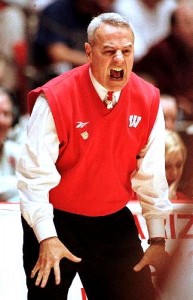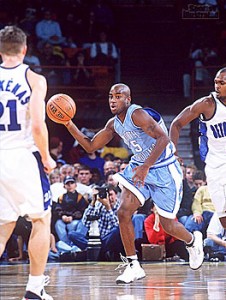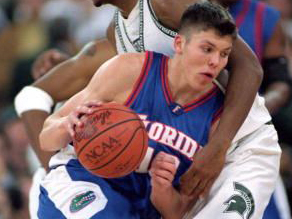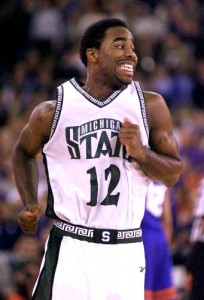Past Imperfect: Y2K Chaos hits NCAAs
Posted by JWeill on March 31st, 2011Past Imperfect is a series focusing on the history of the game. Each week, RTC contributor JL Weill (@AgonicaBoss| Email) highlights some piece of historical arcana that may (or may not) be relevant to today’s college basketball landscape. This week: the random, whacked-out, weirdo 2000 NCAA Final Four.
One Final Four team shouldn’t even be in the tournament. Another surprise team plays a grind-it-out style with no star power. A third team is a batch of mostly young kids who needed a buzzer beater to even get out of the first round. The last team at the Final Four – call it the favorite — is powered by a short point guard and a slasher who seems to be getting better by the game and a bunch of spare parts.
2011? Nope. Try 11 years earlier, when a bunch of random happened to college basketball.
It was a watershed moment for the sport. Or so we thought, anyway. Everything had changed, forever. It was the era of parity, the New World Order for basketball. There would be no kings anymore. Fear the Tulsas and the Wisconsins and the Iowa States from here on out. But other than that wacky March and early April of 2000, for the most part the college basketball world has actually been a pretty normal place ever since. Yes, there have been a few Final Four interlopers in the interim: George Mason, Indiana, Georgia Tech. But mostly it’s been a whole bunch of Duke and Florida and North Carolina and, well, Duke. But forgive yourselves if you weren’t able to accurately predict the future way back then. After all, this was right after all the world’s computers should have melted down, wreaking untold havoc on all humanity, wasn’t it?
Havoc was exactly what it looked like, though, in bracket pools everywhere in the Spring of 2000, thanks to a motley crew assembled in Indianapolis for the 2000 NCAA Final Four that was about as unpredictable as they come. Of the quartet, only Michigan State was “supposed” to be there, the only No. 1 (or 2 or 3 or even 4, for that matter) seed to even make it past the Sweet 16. The combined seeds of the four teams to reach the RCA Dome came to an astounding 22, far surpassing the total for any other single Final Four. Well, until 2011, that is.
The Spartans were familiar with the Final Four, having made the tournament’s last weekend the season before only to lose to Duke. After that game, seniors-to-be Mateen Cleaves and Morris Peterson determined they would not be denied a second time. Of course, that’s always easier to say than it is to do. Michigan State trailed in the second half of three of its tournament games before reaching the semifinals. But each time the Spartans’ blend of experience, talent and football toughness – intentionally bred by their football-loving coach Tom Izzo – proved enough to overcome both deficit and, eventually, the opponent.
This was, in fact, the team that defined Izzo’s tenure at Michigan State. After so many Final Four appearances and so many wins, fans and pundits have come to expect Izzo’s teams to play that Izzo style of gritty bruiser ballet. But while the 1999 Spartans did leap past Kentucky and into the Final Four, it was this group in 2000 that established the base line for all the Michigan State units that followed.
But even if Michigan State was the prohibitive favorite on Final Four weekend, the underdog has upset the status quo enough times that there was no reason to take for granted the Big Ten champions would waltz to the crown. First standing in their way was a familiar Big Ten foe in an unfamiliar place.
Today, Wisconsin is a well-known basketball school. Under coach Bo Ryan, the Badgers have competed in 10 straight NCAA tournaments and finished in the top half of the Big Ten each of those seasons. But it wasn’t always this way. It took a decidedly unconventional coach to lay the groundwork for the annual Big Ten contender we see now. Before Dick Bennett took over the reins of the Badger basketball program in 1995, it had been to one NCAA tournament since 1947. One. The markedly unflashy Bennett came to Madison, Wisc., with a record of consistent, slow-building success at Wisconsin-Green Bay. Taking over a program where basketball mostly seemed like what happened between hockey season and spring football practice,. Bennett started from scratch and built a team that might not always look pretty but whose toughness and spine would please any hockey or football fan. And most importantly, the Badgers began to win.
Year One brought 17 wins and an NIT berth; Year Two, a spot in the NCAA tournament. And yet, despite the newfound success the Badgers were having, no one remotely expected what happened in March of 2000. Relying on its slow-it-down, possession-by-possession style, Wisconsin beat Fresno State then stunned college basketball by ending No. 1 seed Arizona’s season in the second round. The Badgers got past LSU in the Sweet 16, then bested Gene Keady and Purdue in the Elite Eight to earn Wisconsin’s first trip to the Final Four since 1941. Basketball purists might have winced at the scores Wisconsin’s deliberate style produced, but the results were unmistakable. The Badgers never scored more than 66 points in the first four rounds, but won each game. Now, they would meet Michigan State in the NCAA’s Final Four.
On the other side of the bracket, chaos reigned as well. Though its jerseys might have had the regal baby blue ‘North Carolina’ emblazoned on them, few recognized the team wearing them. In the third year since legendary Tar Heels coach Dean Smith had retired, his longtime assistant and replacement Bill Gutheridge had spent a season under duress, maligned for his recruiting and for what UNC’s fan base saw as subpar play. It was hard to argue with that, though. North Carolina came into the NCAAs as an unfamiliar 8 seed, and sporting a pedestrian 18-13 record, including consecutive losses to end the season. Some argued the Tar Heels didn’t really even deserve a spot in the tournament, but once they were in, something changed. Chemistry improved, and plays that just weeks before were resulting in bad shots or turnovers were suddenly producing layups and dunks.
Senior point guard Ed Cota, who was the unquestionable leader and heart of that team, took it upon himself to run the offense and the defense, willing his teammates to make the extra pass, the deflection, to bear down and make that one more stop on defense. The result was a surprising run past Missouri, No. 1 seed Stanford and No. 4 seed Tennessee before out-toughing fellow upstart Tulsa – coached by future title-winning coach Bill Self – in the Elite Eight. UNC had always possessed the talent, but had finally managed to put together the cohesiveness and grit that had been lacking for much of the regular season.
Arguably no one in the field had more talent available that year than Florida. The Gators’ trouble was, however, that all that talent was so young that generating the consistency necessary to win four-five-six straight games in three weeks seemed unlikely. Florida featured 11 players who were freshmen or sophomores. But with guards Brett Nelson and Teddy Dupay, as well as forwards Mike Miller, Donnell Harvey, Udonis Haslem and senior Brent Wright, Florida could throw body after body, talented player after talented player at teams and wear them down physically and mentally. The Gators’ style, however, was also loose, and turnovers and bouts of sloppy play could keep teams in the game. It almost cost Florida in the tournament’s opening round, when only Miller’s floater at the buzzer saved the Gators from an upset at the hands of 12th-seeded Butler. After that scare, Florida pushed its way past Illinois, No. 1 Duke and Oklahoma State to make it to Indy.
It’s important to remember now that much of the basketball world at the time was bemoaning the effect that the NBA Draft was having on the college basketball talent pool. Year after year, it seemed the best young players – the guys who just a decade earlier would have been working their way into college lineups and gracing highlight reels at Kentucky, Duke, UCLA or their ilk were now choosing to become overnight millionaires instead. Guys who once played two or three years in college were going pro after one, and borderline high schoolers were testing their lot in the draft in lieu of playing any collegiate basketball.
That’s one of the things that made the Michigan State Spartans so tough: experience. Led by seniors point guard Mateen Cleaves and swingman Morris Peterson, Michigan State was the odds-on favorite to win the national title after Cincinnati forward and national Player of the Year Kenyon Martin was lost to a broken foot in the Bearcats’ conference tournament. Michigan State had worked its way past Valparaiso, Utah and Syracuse before passing a stern test in No. 2 seed Iowa State, with All-American post player Marcus Fizer. Now the Spartans would face a whole new test in Wisconsin’s methodical style.
The Badgers had played Michigan State three times already that season, and lost all three. But those Wisconsin players weren’t as confident and committed to the system as they were now, having seen what can happen when a group comes together as a team. It would be an ugly game, defense-driven and physical, just like Wisconsin wanted it. A 19-17 first half saw each team go six minutes without a point and Michigan State go the final 11:42 without a field goal. At the break, both teams were beaten down, tired and emotionally frustrated. But Izzo knew that his team had one thing that its opponent could not match: athleticism. So he unleashed the team’s slashing and shooting leader, Peterson, in the second half.
On a series of spins, rebound putbacks and jumpers, Peterson went on a personal 11-point tear to sink the Badgers into a hole that they would not — stylistically, could not – climb out of. The 53-41 Michigan State victory might not have won any points for beauty, but there was no doubt both teams played hard and left all they had on the floor. After the game, Cleaves and the rest of the Spartans expressed relief that they wouldn’t have to meet up with their Big Ten brothers, whose ugly but effective style made everybody man up, any more that season. Now the Spartans were headed to face the winner of the other semifinal with a chance to erase the bad memories of a season before.
In a matchup of talented but erratic teams, Florida sought to minimize the effect of emerging UNC big man Brendan Haywood down low. Speeding up the tempo and pressing on defense for nearly all of the game, Florida negated the size advantage UNC possessed and forced 17 Tar Heels turnovers. North Carolina had little depth, and the running and trapping would take its toll. Florida opened the game on a tear, blitzing the Tar Heels to an 18-3 lead. But UNC calmed down and got the ball inside, where Haywood had no match. The Carolina big man showed the touch that helped him lead the nation in shooting percentage that season, going 5-for-6 and scoring 16 first-half points.
But Florida’s depth eventually wore down a North Carolina team that only went about six players deep. Foul trouble forced Cota to play tentatively on both ends, and UNC sophomore shooting guard Joe Forte was also handicapped with fouls. The end result was a 71-59 Florida win that sent the young Gators to within a single victory of a national championship.
Michigan State had made its entire season about redemption, about finishing off what they felt they’d left unfinished in the ’99 Final Four loss to Duke. Now, standing in the way of that redemption was a young, fast, fearless Florida team who didn’t know that this was Michigan State’s title to lose. In that way, Florida was a reflection of its 34-year-old head coach, Billy Donovan, whose frenetic style and Rick Pitino pedigree seemed to have him on the fast track even before he got to the ’00 Final Four.
But in this championship game, as in so many others, experience and guile would prevail over youth and energy. Cleaves, Peterson and junior forward A.J. Granger found seams in the Florida press for layups, racing to an 11-point halftime lead. With roughly 16 minutes remaining, Cleaves sprained his ankle on a rough foul from Dupay. But there was no way the senior leader and heart of the Spartans was going to watch the conclusion of this game. Once he returned, ankle taped, Cleaves spurred the Spartans on to a 21-9 run, ending the Gators’ upset hopes and capping a mission of a season for Michigan State in the 89-76 victory.
It was an odd end to a strange Final Four – the only No. 1 seed taking the title, after all that talk about new blood and old styles and traditional powers finding new life. Mateen Cleaves and Morris Peterson, boyhood friends in Flint, Mich., and senior leaders for the Spartans, had worked harder, played better — been better – and had now brought a national championship home. Maybe there’s a lesson there, that amid chaos, you must look to the familiar for guidance. Or, maybe, the best team sometimes does win.














































